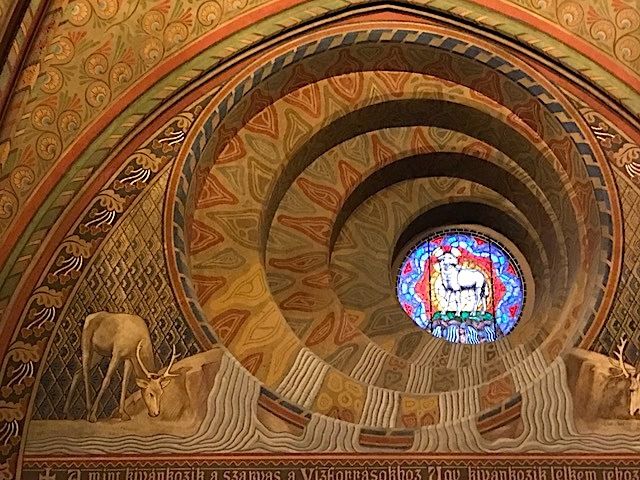
When I first visited Budapest seventeen years ago, a decade after the Soviets rolled out of Hungary, the city was still in the grip of a post-war drabness that masked its historic grandeur. The one good hotel’s only questionable pretense to civility was that it banned hookers from the rooms. Most restaurants served the same menu of heavy Hungarian food without access to good ingredients. Budapest simply wasn’t ready for prime time tourism. But what a difference the Soviets’ leaving has had on this glorious European capital! Entrepreneurs moved in to bolster the tourist industry, restoring the antique buildings and museums in the Castle area, global hotel chains opened outposts, and restaurants blossomed everywhere.
Indeed, on my trip this winter I found Budapest now to rank with the most beautiful and sophisticated cities in Europe, not least for its use of public lighting that brightens all that was once dark, from the grand Opera House (right), now being modernized and enlarged, on the broad Andrássy út and the majestic Parliament on Kossuth Square to the churches and shops along tiny streets and avenues leading to the romantic Danube River, which has never looked blue-er, plied by tour boats, its banks lined with promenades and street car lanes. The city’s great-again architecture reflects the once unquestioned power and wealth of the Austro-Hungarian Empire, after the city of Buda was combined with Pest in 1873. The Castle area, on the Buda side, (reached by funicular, footpath or, the best way, bus) is compact and far more quaint than Pest, and it is a joy to walk the narrow streets after wandering the vast halls of the Hungarian National Gallery, which not too long ago seemed filled with little but huge paintings of Hungarian armies beating back the Turkish invaders. Today, it has emerged as one of the world’s finest museums, and, with further reconfiguring to come, it will be even more inclusive of art from every century and prove that the Hungarian artists of the 19th and 20th centuries both absorbed and manifested the leading movements of their time.

Buda’s Old Town, begun in the 13th century, suffered through various wars, but today looks as handsome and kempt as ever in its history, its cobblestone streets lined with cafés, bistros, hotels, a Museum of Military History, a pharmacy museum, even an English bookstore. The town’s medieval character is best seen on Lords’ Street, where the aristocracy once lived (60 of the old homes have been restored) and in Holy Trinity Square, where the enduring majesty of Hungary’s Catholic religion can be measured in the exquisite interior of Mátyás Church, with every square inch of it painted in beautiful colors and motifs (above), dating to the late 19th century, though the church, devoted to the Virgin Mary, goes back many centuries. Back across the Danube, which you cross on the beloved Chain Link Bridge (above), the new splendor of Pest is revealed in a panoply of buildings in myriad styles, from the splendidly baroque St. Anne’s Church to the magnificent Neo-classic St. Stephen’s Basilica, built between 1845 and 1905 (its original dome collapsed in 1868). The church centers the city and all roads seem to lead to it, its height towering above all else.

Right in front of the Chain Link Bridge is what is now The Four Seasons Hotel (above), of which I shall be writing more in an upcoming article, a very fine example of Secession architecture. It was once called Gresham Palace—built in 1907 by London’s Gresham Life Assurance Company—which a 1999 guidebook describes as having “a crumbling façade.” Today, that façade has been restored to show all the magnificence Lord Gresham (of “Gresham’s Law”) intended, from its ornately carved windows and stone sculptures and its grand interior arcades with a glass dome hung with a beehive-like crystal chandelier that lets the soft Hungarian sun pour through.

Kossuth Square expands away from the river and is dominated by the great Neo-Gothic Parliament building, 880 feet long and 315 feet tall, with a gilded dome once topped in the post-war years with a red Communist star, but that is long gone. The building also houses a hall of Gobelin tapestries, and a grand staircase decorated by Hungarian masters like Károly Lotz and György Kiss. There are so many neighborhoods and quarters being gentrified throughout Budapest that, once a city where one wandered aimlessly amidst shabby, ill-lighted gray buildings, one now meanders slowly to take in its unique cultural heritage evident even in the back streets as much as on the sweeping boulevards. Indeed, in the past decade Budapest has emerged as finer than it ever was, ready to take its place again among Europe’s most important modern metropolises. The people move faster now, but slow down to eat and drink better, and it is palpable in their manners and greetings just how proud they are to welcome visitors to a city that once was off limits to much of the world.
